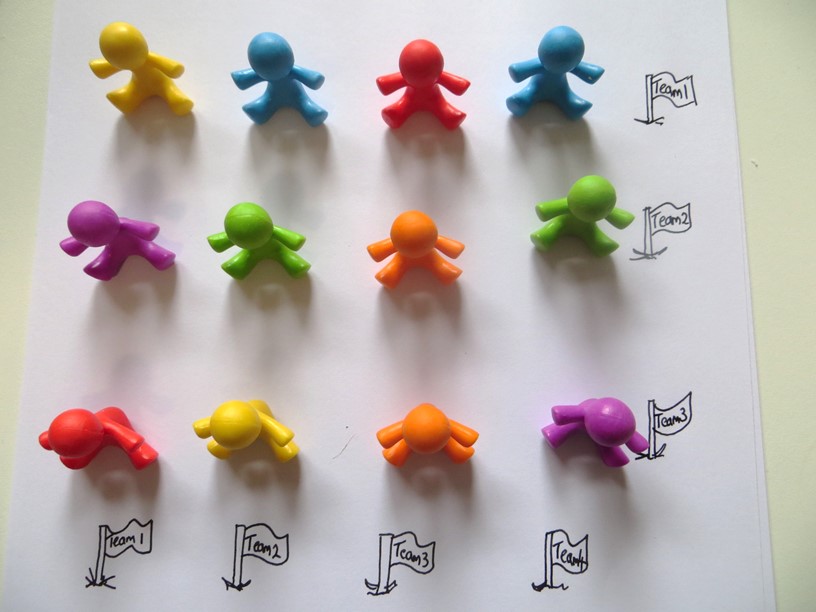The purpose of this activity is to support students using division to solve repeated subtraction problems. Students work with easier division facts, such as divisors of two, five, ten and three.
- Individual objects of interest to students. This lesson uses family counters.
- Challenge students to apply the commutative property of multiplication to division through repeated subtraction situations. Record relevant multiplication and division equations throughout discussion.
- Begin with a simple division example. An array model may support students to see connections.
I have 12 people and I put them into teams of four. How many teams do I make? (12 ÷ 4 = 3). - Change the problem to: I have 12 people and I put them into teams of three. How many teams do I make? (12 ÷ 3 = 4)
- Both these problems use the same multiplication fact. What fact is that? (4 x 3 = 12 or 3 x 4 = 12)
- Draw attention to the connections between the two division equations: 12 ÷ 4 = 3 and 12 ÷ 3 = 4.
- Emphasise that the equations represent different repeated subtraction situations. You might model this using schematic diagrams, written equations, and/or movement of the people counters.

- Use further examples, that draw on relevant real-life contexts, to emphasise the link between repeated subtraction and division. Examples might be:
- 30 people are put into teams of three. How many teams are made? (30 ÷ 3 = 10)
30 people are put into teams of ten. How many teams are made? (30 ÷ 10 = 3) - 40 people are put into teams of five. How many teams are made? (40 ÷ 5 = 8)
40 people are put into teams of eight. How many teams are made? (40 ÷ 8 = 5).
- 30 people are put into teams of three. How many teams are made? (30 ÷ 3 = 10)
Allow students to work in groupings that will encourage peer scaffolding and extension. Some students might benefit from working independently, whilst others might need further support from the teacher. Consider also the different means of action and expression (e.g. verbal, written, digital, physical) that your students might use to demonstrate their thinking.
If appropriate to your students' understanding, you might introduce relevant to reo Māori kupu, such as whakarea (multiply, multiplication) and whakawehe (divide, division).
- Progress to working with stories and equations without the support of physical models. Such as:
- There are 18 people. They form pairs. How many pairs are made?
What is the equation for this story? (18 ÷ 2 = 9). - How many teams of nine can we make with 18 people?
What is the division equation for that problem? (18 ÷ 9 = 2). - Pose a similar problem with 50 ÷ 10 = 5 and 50 ÷ 5 = 10.
Next steps
- Increase the level of abstraction by using diagrams without visible numbers of people, before progressing to stories and equations only. Push up the dividend (number of people) to make additive and diagrammatic strategies less favourable. That will encourage students to use division.
- Ask anticipatory questions like, “if I know 3 x 8 = 24, what other ‘groups of people’ problems can I solve?”
- Extend the problems to include further related facts. Students may recognise connections in multiplication situations but may find it more difficult to transfer their knowledge to repeated subtraction situations. For example:
- If you know 40 ÷ 4 = 10 (40 people into teams of four), can you also figure out 40 ÷ 8 = 5 and 40 ÷ 2 = 20?
- If you know 14 ÷ 2 = 7 (14 people into teams of two), can you also figure out 28 ÷ 2 = 14 (double 7) and 28 ÷ 4 = 7?